Chagas Disease
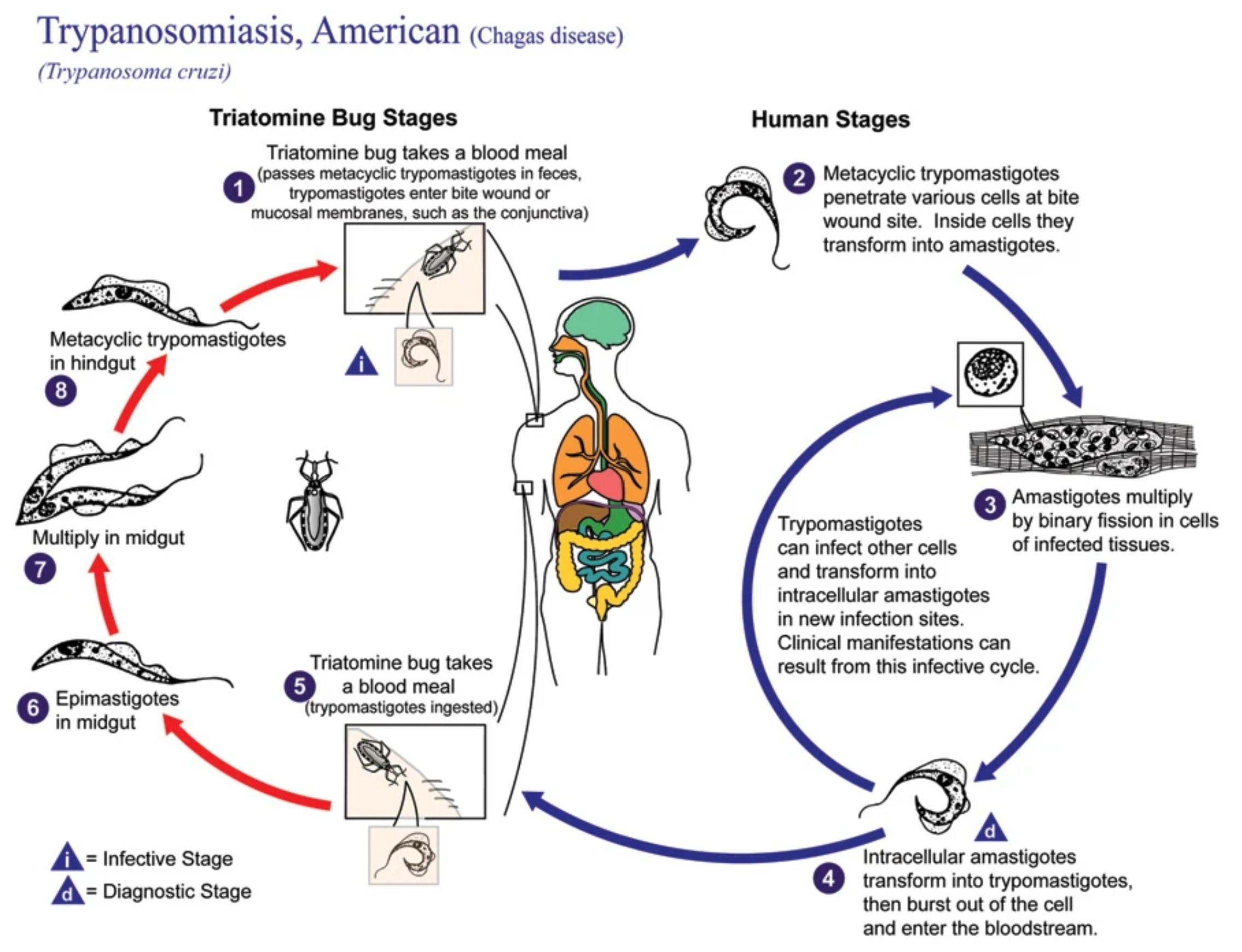
- 18 Aug 2025
In News:
- Chagas disease, or American trypanosomiasis, is an infection caused by the protozoan Trypanosoma cruzi and is transmitted primarily through the feces of triatomine bugs—commonly known as “kissing bugs.”
- It can also spread via congenital transmission (from mother to child), contaminated food or water, blood transfusion, organ transplant, or during laboratory handling.
- Though initially endemic to South and Central America, and Mexico, the disease has now emerged as a global health concern, partly due to migration and local vector presence in places like the southern United States.
Clinical Progression & Treatment
- Many infected individuals remain asymptomatic initially, but chronic infection can lead to severe cardiac and digestive complications if left untreated.
- In the acute phase, antiparasitic treatment is aimed at eliminating the parasite. In the chronic phase, therapeutic focus shifts to managing symptoms since parasite clearance becomes difficult.
Alarming Underinvestment in R&D
- R&D investment for Chagas disease is startlingly low—accounting for only 0.6% of all neglected disease research globally.
- This share is even smaller when compared to other tropical diseases: less than US$1 million was spent on new drug development in 2007, constituting a mere 0.04% of neglected disease R&D funding.
- Between 2009 and 2018, US$236 million was invested in Chagas-related R&D—just 0.67% of the total neglected disease investment. Only a handful of funders (NIH, industry, Wellcome Trust) accounted for the majority.
- Patent data reflect this disparity, especially in vaccine development—highlighting significant underinvestment relative to the global health threat posed by Chagas.
- To put it in perspective, malaria receives 20 times more funding than Chagas.
Pathways to Progress
- Innovative Therapies: Research shows promise in novel, low-cost immunotherapeutic agents derived from cyanobacteria that may offer safer and more tolerable options than current drugs.
- Campaigns and Advocacy: Initiatives like the “Chagas: Time to Treat” campaign by DNDi (Drugs for Neglected Diseases Initiative) emphasize urgent need for:
- Affordable, pediatric formulations
- Safe, field-ready treatments for chronic phases
- Greater public and private funding for R&D.
Broader Significance and Current Calls to Action
- Chagas disease remains among the most neglected tropical diseases, impacting an estimated 6 million people, causing approximately 12,000 deaths annually, and contributing to over 30,000 new cases each year—mainly in Latin America.
- Effective solutions require:
- Improved surveillance and mandatory case notification systems
- Enhanced training and diagnostic tools for health workers
- Integration of One Health approaches (veterinary, environmental control, and human health) in vector management.
- Investment in neglected disease R&D delivers substantial societal returns—studies suggest $1 spent yields $405 in broader economic and health benefits.
18th International Olympiad on Astronomy and Astrophysics
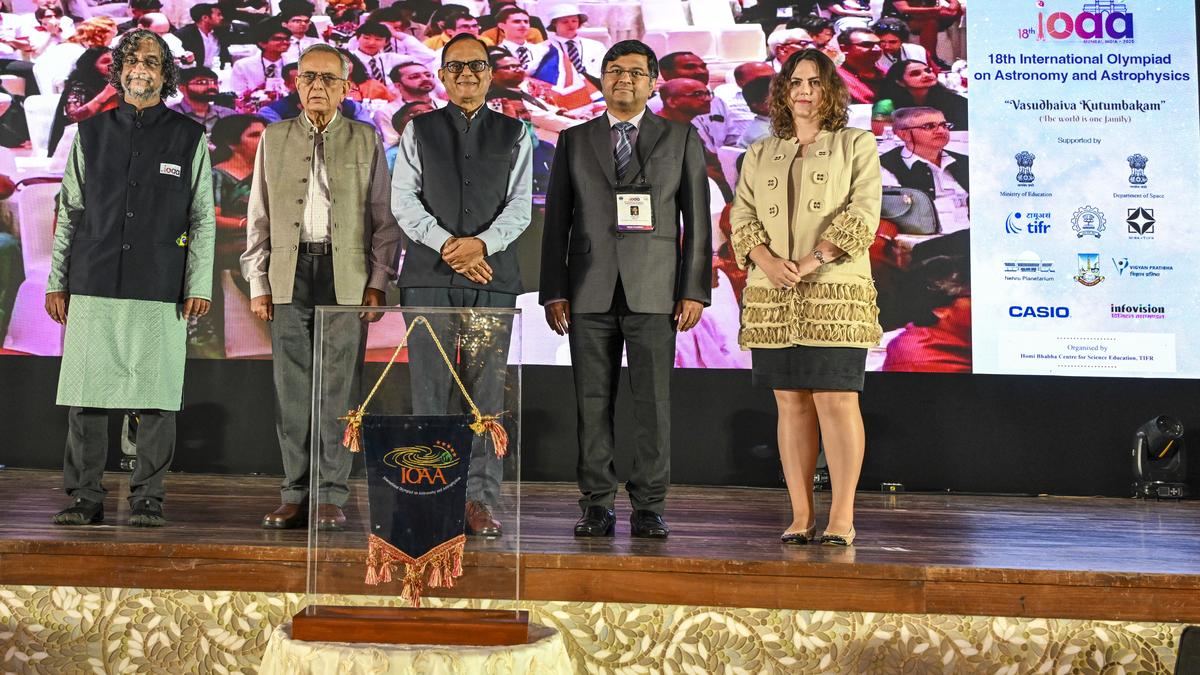
- 18 Aug 2025
In News:
India is hosting the 18th International Olympiad on Astronomy and Astrophysics (IOAA) in Mumbai, Maharashtra, with participation from over 300 young astronomers from 64 countries. The event is jointly organised by the Homi Bhabha Centre for Science Education (HBCSE), Tata Institute of Fundamental Research (TIFR), and the Union Ministry of Education.
About IOAA:
- A premier global competition for high-school students in astronomy, astrophysics, and observational sciences.
- Tests theoretical knowledge, data analysis skills, and observational abilities.
- Objectives:
- Promote scientific thinking and problem-solving in space sciences.
- Encourage international cooperation and cultural exchange.
- Inspire careers in space sciences and research.
- Showcase India’s scientific and technological progress.
Features of the 18th Edition:
- Largest-ever IOAA with record participation from 64 nations.
- Competition includes written exams, data analysis, and night-sky observations.
- Highlighting India’s legacy: From Aryabhatta’s discoveries to modern space missions like Chandrayaan-3 (historic landing near Moon’s South Pole) and Aditya-L1 (India’s first solar observatory).
- Showcasing STEM Empowerment:
- Atal Tinkering Labs benefitting over 10 million students through hands-on STEM learning.
- One Nation One Subscription scheme providing free access to global research journals for students and researchers.
- Global Collaboration: Participation in mega-science projects such as the Square Kilometre Array and LIGO-India.
Significance for India:
- Strengthens India’s global image as a leader in space sciences and STEM education.
- Provides a platform for showcasing India’s scientific achievements and educational initiatives.
- Encourages the next generation to pursue careers in astronomy, astrophysics, and research.
- Aligns with India’s broader vision of linking science, innovation, and human welfare.
UNDP Equator Initiative Award 2025
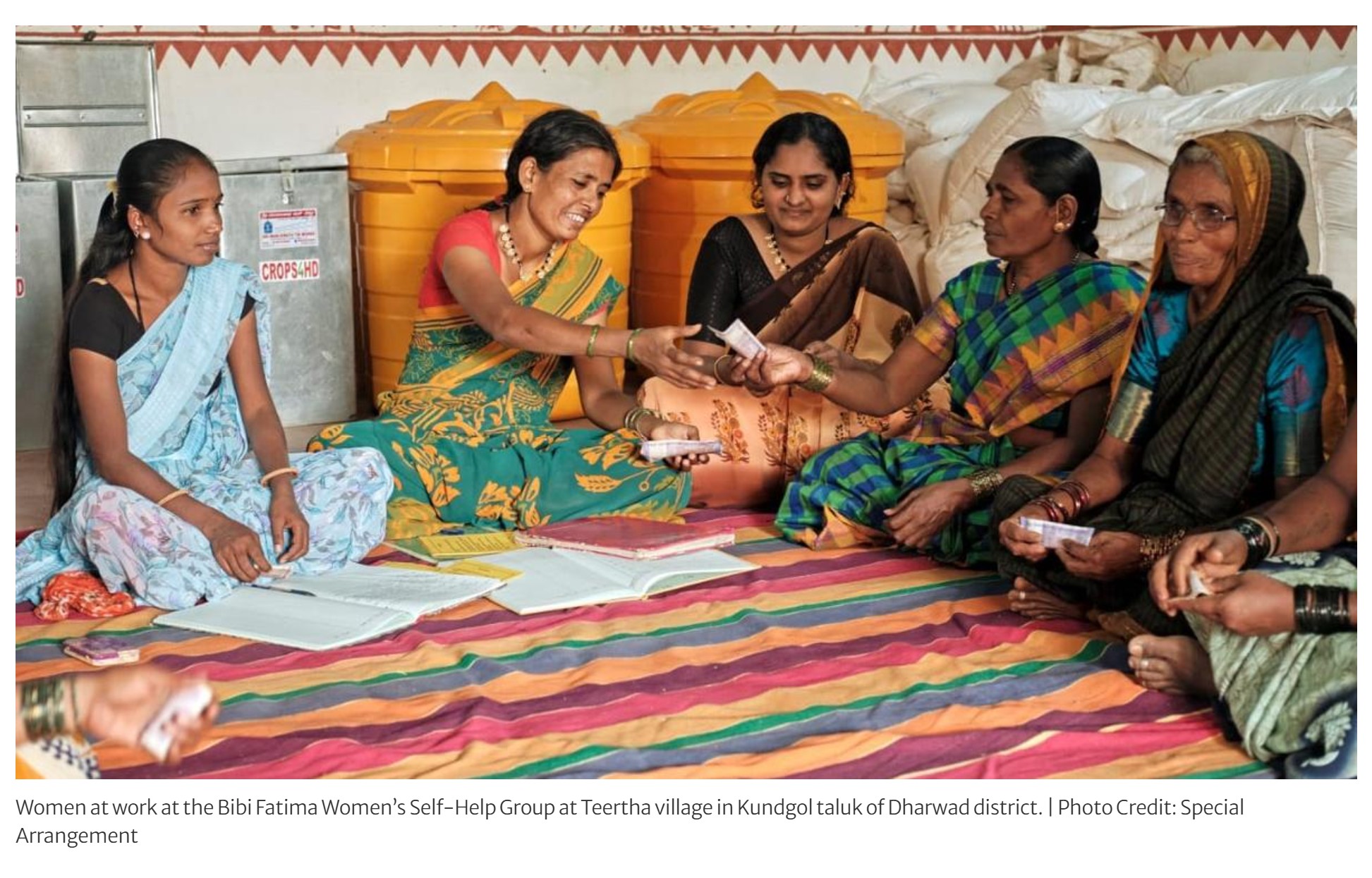
- 18 Aug 2025
In News:
The Bibi Fatima Women’s Self-Help Group (SHG) from Teertha village, Kundgol taluk, Dharwad district, Karnataka, has won the prestigious Equator Initiative Award 2025. The award, often referred to as the Nobel Prize for Biodiversity Conservation, honours community-led, nature-based solutions for sustainable development.
About the Equator Initiative Award:
- Organiser: United Nations Development Programme (UNDP) under its Equator Initiative.
- Nature: Recognises local and indigenous communities for biodiversity conservation, ecological resilience, and poverty reduction.
- Frequency: Biennial.
- Prize: Includes a cash award of $10,000 (approx. ?8.5 lakh).
- Theme (2025):“Women and Youth Leadership for Nature-Based Climate Action”.
- Eligibility: The initiative must have been active for at least three years, community-based, and contribute to at least two Sustainable Development Goals (SDGs).
In 2025, Bibi Fatima SHG was the only Indian winner, alongside groups from Argentina, Brazil, Ecuador, Indonesia, Kenya, Papua New Guinea, Peru, and Tanzania.
Achievements of Bibi Fatima SHG:
- Formation: Established in 2018 by 15 women, with support from Sahaja Samruddha (NGO), Indian Institute of Millets Research (IIMR, Hyderabad), and CROPS4HD.
- Eco-Friendly Farming: Revived millet-based mixed cropping systems on rainfed lands through natural and climate-resilient farming practices in nearly 30 villages.
- Community Seed Bank: Distributes millet seeds free of cost to farmers, strengthening local seed sovereignty.
- Food & Nutrition Security: Promoted millets to improve dietary diversity and resilience against climate change.
- Women-led Enterprise: Established a solar-powered millet processing unit with support from SELCO Foundation, entirely managed by women.
- Value Addition & Marketing: Produces millet-based products such as rotis and vermicelli, boosting local markets.
- Livelihood Diversification: Expanded into livestock rearing, horticulture, and farmers’ markets, improving incomes of small and marginal households.
- Partnerships: Collaborates with Devadhanya Farmer Producer Company to scale rural, agriculture-based enterprises.
Significance:
- Strengthens the role of women’s leadership in climate action and sustainable agriculture.
- Demonstrates a successful community-driven model for biodiversity conservation, food security, and rural entrepreneurship.
- Aligns with India’s efforts to revive millets (International Year of Millets 2023) and promote climate-resilient farming.
- Advances multiple SDGs – notably SDG 1 (No Poverty), SDG 2 (Zero Hunger), SDG 5 (Gender Equality), SDG 12 (Responsible Consumption and Production), and SDG 13 (Climate Action).
State Health Regulatory Excellence Index
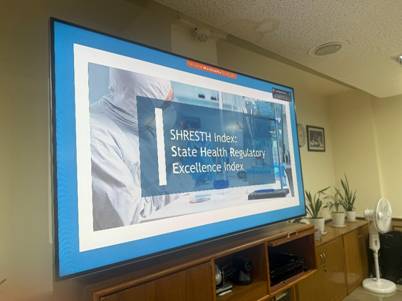
- 18 Aug 2025
In News:
The Union Health Secretary, Smt. Punya Salila Srivastava, recently launched the State Health Regulatory Excellence Index (SHRESTH), a first-of-its-kind national framework to benchmark and strengthen state drug regulatory systems through transparent, data-driven assessments. The initiative has been developed by the Central Drugs Standard Control Organization (CDSCO) in collaboration with states and UTs.
About SHRESTH:
- Objective: To improve the performance of state drug regulatory authorities, ensuring drug safety, quality, and efficacy across India.
- Nature: Functions as a virtual gap-assessment tool, enabling states to measure their regulatory preparedness and move towards maturity certification.
- Categories of States:
- Manufacturing States: Assessed on 27 indices under five themes – Human Resources, Infrastructure, Licensing Activities, Surveillance Activities, Responsiveness.
- Primarily Distribution States/UTs: Assessed on 23 indices under similar themes.
- Process:
- States/UTs submit predefined data to CDSCO by the 25th of every month.
- Metrics are scored on the 1st of the following month and shared with all states/UTs.
- Significance:
- Enables targeted improvements in infrastructure, digitisation, inspection, and grievance redressal.
- Promotes cross-learning by sharing best practices of top-performing states.
- Provides a roadmap rather than a scorecard, encouraging harmonization of drug regulatory systems nationwide.
Wallacean Hominids
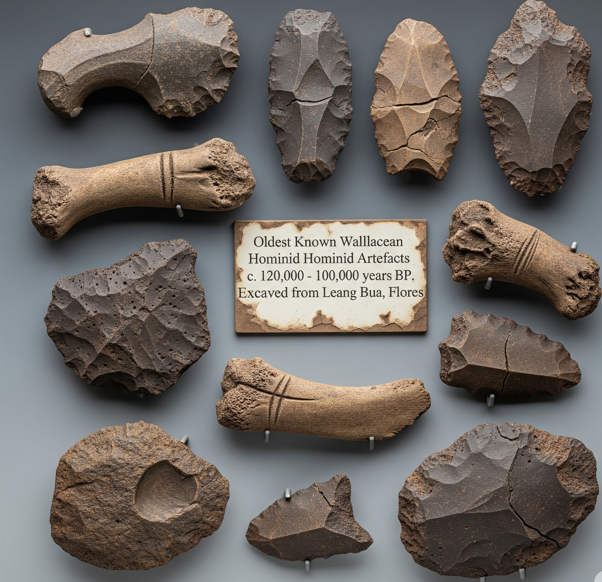
- 18 Aug 2025
In News:
Recent archaeological findings on Sulawesi Island, Indonesia, have revealed stone tools dating back to nearly 1.5 million years ago, marking the earliest known evidence of human presence in the Wallacea region.
Key Findings:
- Archaeologists from Australia and Indonesia discovered small, chipped stone tools in the Soppeng region of South Sulawesi.
- The artefacts, likely used to cut small animals and carve rocks, were found along with animal teeth.
- Radioactive dating suggests the tools are up to 1.48 million years old.
- These findings were published in Nature (August 2025).
Significance:
- The artefacts are attributed to Homo erectus, pre-historic hominids that lived long before the emergence of Homo sapiens.
- Previously, Homo erectus in Wallacea were thought to have occupied only Flores (Indonesia) and Luzon (Philippines) around 1.02 million years ago.
- The Sulawesi discovery pushes back the timeline by almost half a million years, challenging earlier assumptions that Homo erectus lacked the capacity for long-distance sea crossings.
- It provides crucial evidence of early maritime dispersal and migration patterns of ancient humans from the Asian mainland into island ecosystems.
About Wallacea:
- Wallacea is a biogeographic region in Eastern Indonesia, comprising islands such as Sulawesi, Lombok, Flores, Timor, and Sumbawa, situated between Borneo–Java and Australia–New Guinea.
- The region is named after Alfred Russel Wallace, the naturalist who studied its distinct biodiversity.
- It acts as a natural transitional zone between the fauna of Asia and Australia.
